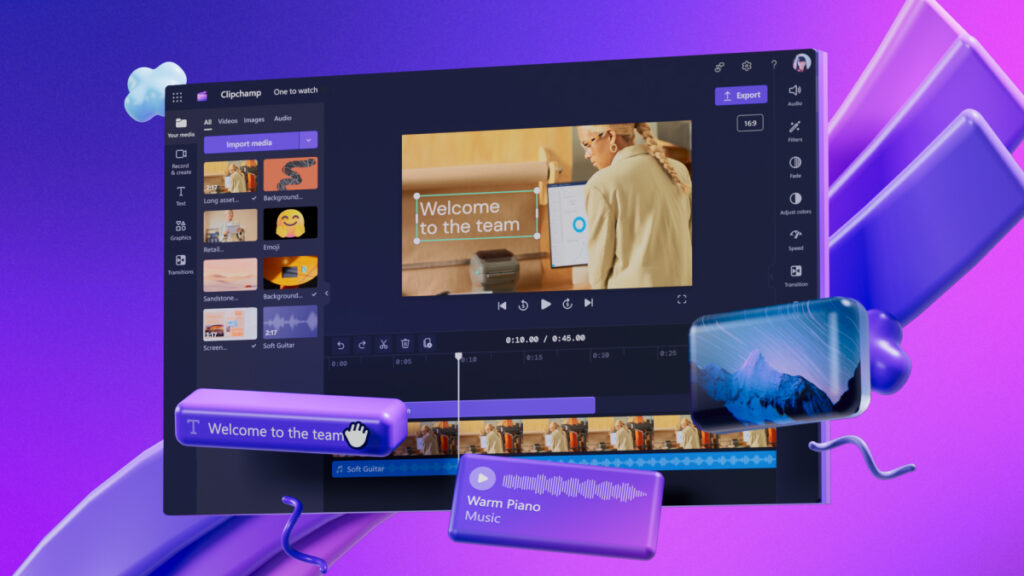
Clipchamp: Microsoft Announces New Tools and Upcoming Features
Microsoft has announced new features for Clipchamp, its native Windows video editor, including transcript-based editing. The coming updates, listed on the Microsoft 365 Roadmap, will allow users to make edits by modifying a transcript, simplifying video editing for projects involving spoken content. The transcript-based editing tool will be available globally by March 2025.
Simplifying Editing Through Transcripts
Currently Clipchamp users work primarily within the timeline interface, which can be challenging for dialogue-intensive videos. The new transcript-based feature will changes that, allowing users to make cuts by editing the text transcript. As explained by Microsoft:
“We are introducing a novel and streamlined method to quickly and accurately remove any unwanted sections from your Clipchamp projects by leveraging the transcript. With transcript-based editing, browsing text, selecting unwanted words, and removing them will remove them from the video without the need to navigate the timeline. We are looking into making video editing more productive by providing a more intuitive and straightforward editing experience.”
Current and Future AI Tools: Background Removal and Noise Suppression
Clipchamp already includes AI-based background removal and noise suppression. The background removal tool enables users to replace existing visuals by right-clicking and selecting “Remove Background,” simplifying a process that usually requires detailed masking.
Noise suppression helps clean up audio by minimizing background sounds like traffic and ambient noise. Users activate this through the Audio tab, improving audio clarity without external software or high-quality microphones. These features are available for Personal and Work accounts; however, Microsoft has not provided updates on their extension to Educational accounts.
Microsoft’s plan to integrate Copilot into Clipchamp, set for September 2025, aims to leverage generative AI capabilities. Copilot will automate tasks such as scriptwriting, sourcing stock footage, and assembling projects complete with voiceovers, text overlays, and music based on user prompts. The tool is designed to streamline the video creation process, will make it more accessible for users who may need help with complex edits or time-consuming project assembly.
Other Features Rolling Out in 2024/2025
Aside from transcript-based editing, March 2025 will also introduce a feature that enables users to share specific segments of their videos as clip links. It will let you define the segment using draggable handles on the timeline and generate a link that plays only the selected portion. Recipients can watch the shared clip and access the full video if desired. And Microsoft has these other updates planned to enhance Clipchamp:
- Unified Video Branded Start Page (December 2024): This feature will merge Clipchamp and Stream into a unified starting interface, making it easier for users to manage video projects.
- Commercial Template Creation (January 2025): Organizations will be able to create custom templates with brand kits, allowing for consistency in video projects.
- Advanced Camera Editing (January 2025): This update will integrate camera capture with the main editing suite, enabling a smoother transition between recording and editing content.
Positioning Clipchamp in Microsoft’s Ecosystem
Since Microsoft acquired Clipchamp in September 2021, the app has become a key video editing tool on Windows 11. It offers a variety of templates, animations, text overlays, and filters to cater to both beginners and more advanced users.
However, Clipchamp’s free version caps exports at 1080p and may apply watermarks. The premium subscription, priced at $11.99 per month or $119.99 annually, unlocks additional features. Microsoft 365 subscribers still need to purchase a separate Clipchamp subscription to access all of the premium capabilities.
For users looking for advanced editing without subscription fees, open-source tools like Kdenlive and DaVinci Resolve provide more complex options, though they come with steeper learning curves.
